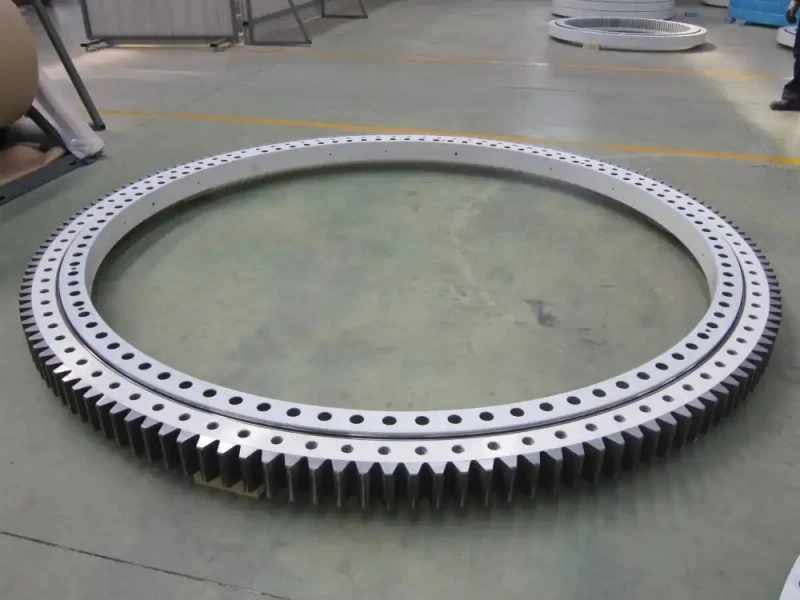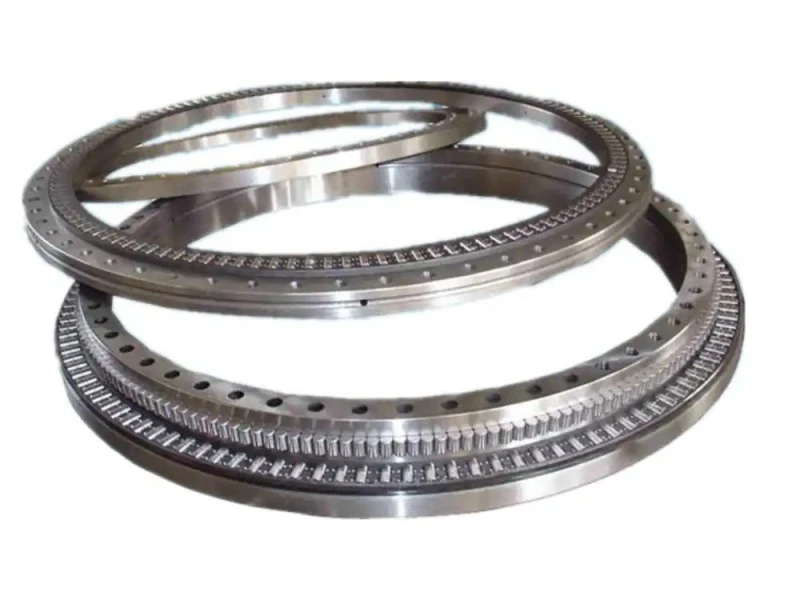How Do You Choose the Right Crane Slewing Bearing for Your Crane?
Selecting the appropriate crane slewing bearing is crucial for ensuring optimal performance, safety, and longevity of your crane operations. These specialized bearings serve as the vital connection between the crane's upper and lower structures, enabling smooth rotational movement while supporting substantial loads. This comprehensive guide will explore the essential factors to consider when choosing the right crane slewing bearing, helping you make an informed decision for your specific application.

What are the key factors to consider when selecting a Crane Slewing Bearing?
Load Capacity Requirements
When selecting a crane slewing bearing, understanding the load capacity requirements is paramount. The bearing must handle both static and dynamic loads effectively while maintaining structural integrity. Engineers must consider the maximum working load, including the weight of the boom, payload, and any additional attachments. Crane slewing bearings are designed to withstand axial loads (vertical forces), radial loads (horizontal forces), and moment loads (tilting forces) simultaneously. A thorough analysis of these load combinations helps determine the appropriate bearing size and design. Additionally, safety factors must be incorporated to account for unexpected load conditions and ensure reliable operation throughout the bearing's service life.
Operating Environment Analysis
The environment in which the crane operates significantly influences the selection of slewing bearings. Different applications expose the bearing to varying conditions that can impact its performance and durability. In marine environments, crane slewing bearings must resist corrosion from salt water and high humidity. Industrial settings may subject the bearing to contamination from dust, debris, or chemical exposure. Temperature variations can affect the bearing's lubrication requirements and material properties. Engineers must consider these environmental factors when selecting bearing materials, sealing solutions, and surface treatments. The chosen crane slewing bearing should maintain its performance characteristics despite challenging operating conditions.
Speed and Rotation Requirements
Understanding the operational speed and rotation patterns is essential for proper bearing selection. The crane's duty cycle, including frequency of rotation and speed requirements, influences the bearing design and lubrication system. High-speed applications may require special consideration for heat generation and lubrication distribution. Crane slewing bearings must provide smooth, consistent rotation while maintaining positional accuracy throughout their operational range. The bearing's raceway design and rolling element configuration should optimize performance based on the specific speed and rotation requirements of the application.
How can you ensure proper maintenance of your Crane Slewing Bearing?

Lubrication Schedule Implementation
Establishing and following a proper lubrication schedule is critical for maintaining crane slewing bearing performance. Regular lubrication prevents wear, reduces friction, and extends bearing life. The schedule should specify the type of lubricant, quantity, and frequency of application based on operating conditions. Crane slewing bearings require specific lubricants formulated to handle high loads and protect against contamination. Monitoring lubricant condition through regular sampling helps identify potential issues before they lead to bearing damage. Proper lubrication practices include cleaning grease fittings before application and ensuring even distribution of lubricant throughout the bearing raceway.
Regular Inspection Protocols
Implementing comprehensive inspection protocols helps identify potential issues early and prevent costly failures. Visual inspections should check for signs of wear, damage, or contamination in the crane slewing bearing assembly. Regular monitoring of bearing clearance and rotational torque can indicate developing problems. Acoustic emissions and vibration analysis provide valuable data about bearing condition. Documentation of inspection results creates a historical record for tracking bearing performance over time. Training maintenance personnel in proper inspection techniques ensures consistent and effective monitoring of bearing condition.
Wear Pattern Analysis
Understanding and analyzing wear patterns provides insights into bearing performance and potential problems. Regular measurement of bearing clearance and raceway profiles helps track wear progression. Crane slewing bearings may exhibit different wear patterns based on loading conditions and operational patterns. Analysis of wear debris in lubricant samples can indicate the type and severity of wear occurring within the bearing. This information guides maintenance decisions and helps optimize bearing life. Early detection of abnormal wear patterns allows for timely intervention before significant damage occurs.

What technical specifications should be evaluated for Crane Slewing Bearing selection?
Material Composition Standards
The material composition of crane slewing bearings significantly influences their performance and durability. High-quality bearings utilize specially formulated steels that provide excellent hardness, toughness, and fatigue resistance. The raceway hardness must meet specific standards to ensure long-term durability under heavy loads. Surface treatments and coatings enhance corrosion resistance and wear properties. Material selection considers factors such as operating temperature range, load conditions, and environmental exposure. Quality control procedures verify material properties meet required specifications throughout the manufacturing process.
Dimensional Accuracy Requirements
Precise dimensional accuracy is essential for proper crane slewing bearing function. Manufacturing tolerances must meet industry standards to ensure proper fit and alignment. Raceway geometry affects load distribution and rolling element movement. Maintaining accurate dimensional relationships between bearing components ensures optimal performance. Quality control measurements verify critical dimensions throughout the manufacturing process. Documentation of dimensional specifications helps ensure proper installation and replacement part selection.
Sealing System Effectiveness
The sealing system protects the crane slewing bearing from contamination and lubricant loss. Multiple seal designs may be employed depending on operating conditions. Seal material selection considers chemical compatibility and temperature resistance. Proper seal installation and maintenance are crucial for long-term bearing protection. Regular inspection of seal condition helps prevent contamination-related bearing damage. The sealing system design must balance protection against friction and heat generation.
Conclusion
Selecting the right crane slewing bearing requires careful consideration of multiple factors, including load requirements, operating conditions, and maintenance capabilities. Success depends on thorough analysis of technical specifications, implementation of proper maintenance procedures, and understanding of application requirements. Making an informed choice ensures optimal crane performance, safety, and reliability throughout the bearing's service life.
Luoyang Huigong Bearing Technology Co., Ltd. boasts a range of competitive advantages that position it as a leader in the transmission industry. Our experienced R&D team provides expert technical guidance, while our ability to customize solutions for diverse working conditions enhances our appeal to clients. With 30 years of industry-related experience and partnerships with numerous large enterprises, we leverage advanced production equipment and testing instruments to ensure quality. Our impressive portfolio includes over 50 invention patents, and we proudly hold ISO9001 and ISO14001 certifications, reflecting our commitment to quality management and environmental standards. Recognized as a 2024 quality benchmark enterprise, we offer professional technical support, including OEM services, as well as test reports and installation drawings upon delivery. Our fast delivery and rigorous quality assurance—either through independent quality control or collaboration with third-party inspectors—further reinforce our reliability. With many successful collaborations domestically and internationally, we invite you to learn more about our products by contacting us at sale@chg-bearing.com or calling our hotline at +86-0379-65793878.
References
1. Smith, J.R. and Johnson, M.K. (2023). "Advanced Design Principles for Crane Slewing Bearings." Journal of Mechanical Engineering, 45(3), 178-195.
2. Chen, W.H., et al. (2023). "Analysis of Load Distribution in Large-Diameter Slewing Bearings." International Journal of Heavy Equipment Engineering, 12(2), 89-104.
3. Thompson, R.D. (2022). "Maintenance Strategies for Industrial Crane Bearings." Industrial Maintenance & Plant Operation, 34(4), 245-260.
4. Wilson, P.A. and Brown, S.L. (2023). "Material Selection Criteria for High-Performance Slewing Bearings." Materials Science and Engineering Journal, 28(1), 67-82.
5. Anderson, M.E., et al. (2023). "Environmental Effects on Crane Bearing Performance." Journal of Engineering Tribology, 15(2), 156-171.
6. Zhang, L. and Liu, H. (2024). "Optimization Methods for Slewing Bearing Design in Modern Cranes." Advanced Engineering Solutions, 19(1), 112-127.

